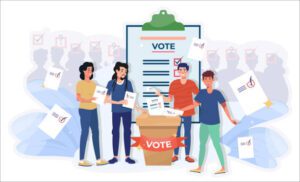In India, there are two electoral systems combined. While proportional representation is utilised for Rajya Sabha and presidential elections, first-past-the-post is used for Lok Sabha and state assembly elections.
According to Indian Express, an all-party parliamentary commission is currently looking into “other systems of elections” in addition to the first-past-the-post (FPTP) system.
All parties and the Election Commission have received a six-page “Questionnaire on Electoral Reforms” from the Parliamentary Standing Committee on Personnel, Public Grievances, Law and Justice.
The many electoral methods used around the world are briefly explained below:
 (Photo from istock)
(Photo from istock)
First-past-the-post:
It is a very basic system. The winning candidate is the one who receives the most votes. Unlike other systems, it is simple to comprehend. Other than India, numerous African nations as well as the US and Canada use it.
Single Transferable Vote: as electoral method
Based on the total number of valid votes cast and the number of seats to be filled, a minimum number of votes must be obtained in order to proclaim a winner. Candidates who obtain enough first-preference votes to meet the required threshold are declared elected. According to a paper by Canadian MP Linda Duncan, a two-step count is carried out if there are still seats open.
Extra Member System: as electoral method
It combines party lists and first-past-the-post districts. Two ballots are provided to each voter. The voter selects their chosen candidate from a list of candidates representing various political parties. The other is a list of parties, each of which has a candidate list prepared in advance. In this case, choosing a party on the second ballot also means choosing that party’s candidate list.
The Alternative Vote Plus:
is another convoluted voting mechanism. To make the total result more proportional, voters use the Alternative Vote, rank candidates in order of preference, and then vote again on a short top-up list. Voters may select their preferred party or candidate from the top-up list, and the votes are then distributed to fairly reflect each party’s share of the vote, according to the top-up list.
Additional Vote:
This is a system of preferential voting. The first box in each column is used by voters to indicate their favourite candidate, while the second box is used to indicate their second favourite. When all of the votes for the candidates with the most support have been counted, the winner is declared if they receive more than 50% of the vote. The top two candidates advance to the run-off round if no contender can pass the halfway point. This continues until one candidate receives the most votes, according to electoral-reform.org.uk.
Two-Round System:
This is much easier to understand. Voters mark the candidate they choose. A candidate is declared elected if they receive 50% of the vote. If not, another vote is taken. Just the top two candidates advance to the second round in some nations.
Alternate Vote:
It’s a little difficult to understand this one. Each contender is given a number by the voter. Whoever receives the most support from voters wins. Your votes will be cast for the second-place contender if the required number of candidates is not met. This goes on until a candidate is victorious.
Supplementary Vote:
This is a system of preferential voting. The first box in each column is used by voters to indicate their favourite candidate, while the second box is used to indicate their second favourite. When all of the votes for the candidates with the most support have been counted, the winner is declared if they receive more than 50% of the vote. The top two candidates advance to the run-off round if no contender can pass the halfway point. This continues until one candidate receives the most votes, according to electoral-reform.org.uk.
Borda Count:
This one isn’t too challenging to understand, according to Borda Count. Voters rank candidates in this form of preferential voting according to their preferences, and those preferences are then translated into points. The winner is the contender with the highest rating.
Party List Proportional Representation:
Each district in this elects a number of MPs, and each area is rather large. Both closed and open lists exist.
- Closed List: On election day, the ballot paper will include a list of the parties, as well as a list of candidates for each area. Voters mark the party they support.
- Open List: A list of candidates is provided by each party. In certain systems, voters have the option to select a specific candidate. In others, voters have the option of supporting a party or a particular candidate.
A little something about electoral system
 (Photo from istock)
(Photo from istock)
One of the primary causes of institutional variety among democratic nations is the voting system. The most widely used distinction is between plurality-majoritarian regimes and proportional representation systems. A party’s vote share determines their share of election seats under proportional representation, a system that frequently results in multiparty coalition governments.
In contrast, in plurality systems the party that receives the most votes usually has sole control over policy. Even if the results have been somewhat conflicting, it is not surprising that the election system influences the incentives for choosing particular types of exchange-rate strategies.
According to several studies, majoritarian electoral systems in democracies are more likely to favor stable exchange rates and to see less exchange-rate volatility during cabinet reshuffles than proportional ones.
Majoritarian, plurality, and proportional electoral systems are the most common varieties. Party-list and single transferable vote (STV) systems are the two primary variations of the former; plurality, majoritarian, and (so-called) semi proportional systems are the three primary variations of the latter.




